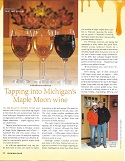Tapping into Michigan’s Maple Moon Wine

By Dianna Stampfler
As the Michigan woods thaw and awaken from their winter slumber, a clear fresh sap begins to flow from the sun-warmed trees that dot the rural landscapes. Regarded as the state’s oldest agricultural activity—dating back to the Native Americans—maple sugaring draws a rich history on the process of boiling down sap into syrup.
Tapping trees has become a new tradition for the Petersen family in Petoskey, owners of Maple Moon Sugarbush and Winery—America’s first and only maple winery. In 2011, after two years of backyard sugaring, Todd and Christi (and their four children) decided to commercially produce Pure Michigan maple syrup as a family business.
As with any agricultural crop, sap changes from farm to farm and region to region, depending on the soil content. The area’s climate and species of trees also play a role in this industry. The ideal spring weather conditions offer warm days with cold freezing nights, found predominantly in the northern states and provinces of North America.
The sugar maple is the preferred tree due to its high sugar content of approximately two percent, although the black maple, red maple, silver maple and ash leafed maple—with a sugar content of about one percent—can also be tapped to produce a different grade of syrup.
Although several Canadian provinces and states in the New England area are recognized as leaders in the maple sugaring industry, Michigan itself has more than three times the number of sugar maples than Quebec or Vermont, meaning the potential for growth is unlimited. Currently, Michigan utilizes less than one percent of its potential maple resources.
The Petersen’s however, are taking full advantage of what nature has given them. Nestled among hardwood forests on a sprawling 80-acre site just east of downtown, Maple Moon has grown into one of the state’s largest maple syrup manufacturers.
In 2015, some 80,000 gallons of sap was collected here, which transformed into 1,600 gallons of finished syrup (the conversion rate is 40 gallons of sap produces one gallon of syrup).
“It was a fantastic year,” says Christi. “Almost a perfect year.”
Each spring, each of the estimated 2,500 pure sugar maple trees are tapped—with as many as three taps, depending on size—and hooked up to an intricate industry specific aerial tubing system that transports the sap to the sugarhouse. From there, the sap begins its transformation into a thick, sweet, golden syrup. There is a detailed multi-step science to it all, with processes including boiling, evaporating, filtering and storing—all of which are covered in-depth during a free tour offered each afternoon at 4pm.
Maple Moon’s rustic tasting room and shop offer mouth-watering treats such as syrup, candy, premium ice cream, granola, jam, salsa, and now, even wine.
In all, nine vintages of wine were offered in 2015, varying from semi-dry to sweet—each delivering maple tones with a cream finish. Unlike other fruit or fortified wines, Maple Moon doesn’t just add maple syrup to their vino—the wine is actually fermented directly from the sugars in the syrup. Sample from Maple Blackberry, Maple Peach, Maple Cherry and Maple Blueberry as well as Early Spring Reserve, Maple Blanc, Maple Rouge, Maple Dessert, Maple Gold—a decadent port-style wine, finished with bourbon, which is among the top-selling products. Unique beverages, such as Maple Ginger Hard Cider and Maple Root Beer, are also offered.
Maple Moon Sugarbush and Winery, at 4454 Atkins Road, is open Thursday through Saturday, from November through May and then Monday through Saturdays, from June to October. It is one of nearly 10 wineries that make up the Bay View Wine Trail, which includes tasting rooms throughout Charlevoix and Emmet counties. Maple Moon is also a founding member of the Commercial Maple Syrup Producers of Michigan.
For more information on Maple Moon, visit mmsyrup.com or call (231) 487-9058.
Reprinted from the Spring 2016 issue of Michigan BLUE Magazine.
